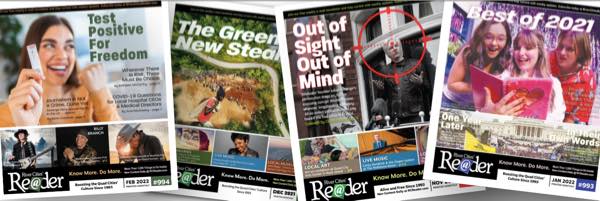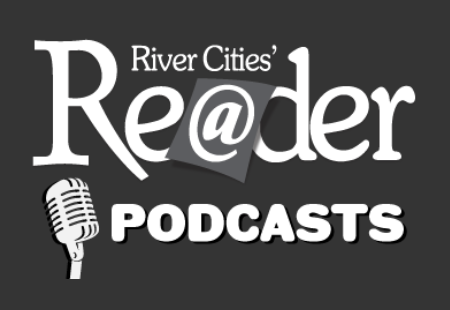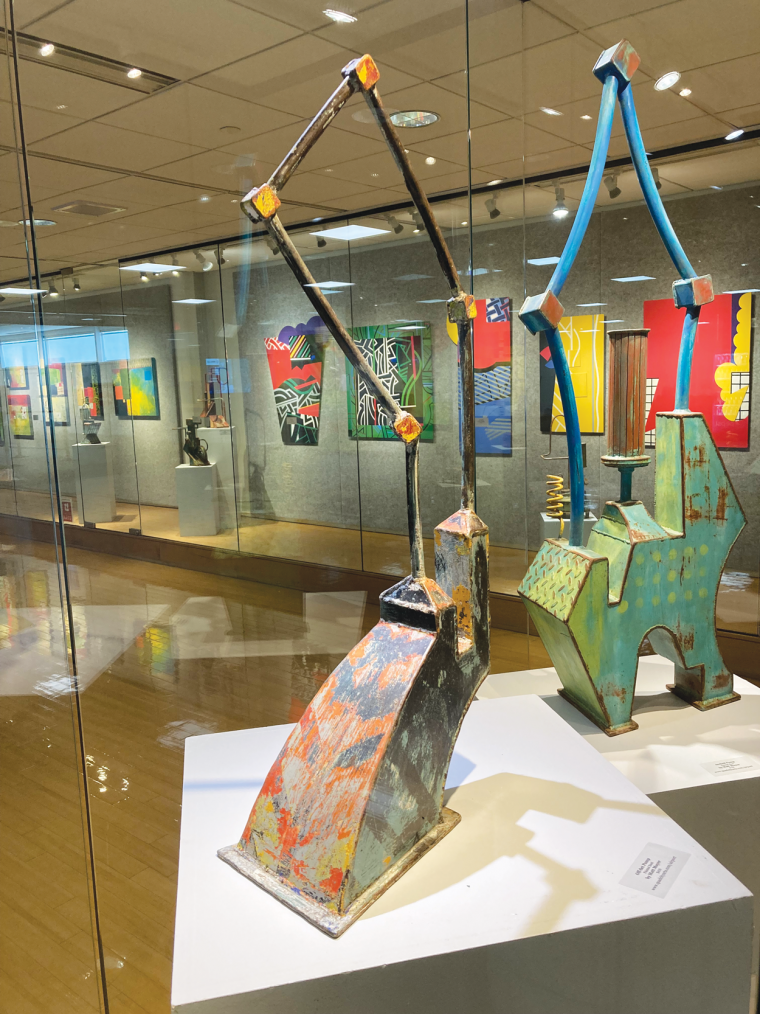
Corrine Smith, Matt Moyer, James Bowden art at the QC International Airport February 2023
The current art exhibit at the Quad Cities airport is one of the most enjoyable I have seen in the nearly 20 years Quad City Arts has curated such displays. If you've never paused to browse the gallery in your travels while flying, or paid the $1 for 30 minutes of short-term parking to take in what is a world-class, museum-level art-display space, you should do so on the next opportunity.
Visual Arts Director Dawn Wohlford-Matello has assembled a trio of well-collected and prolific artists whose recent works gel so effectively, you'd think it was all planned by the artists themselves.

The Reader provided each artist a series of nine questions to help inform this exhibit and their responses are printed below. These artists are Corrine Smith (mixed-media painter), still creating in Rock Island, Illinois; Matt Moyer, originally from Moline, Illinois, and now making sculptures from Columbia, Missouri (just outside of the 250-mile radius curating criteria and given a pass because he played football at Moline High School); and mixed media-painter James Bowden from Peotone, Illinois. Their works are on display at the airport through February 28.
1) How long have you been producing art professionally?
Corrine Smith: Over 40 years.
Matt Moyer: I had my first sculpture exhibited at Quad City Arts when I was about eight years old. My aunt worked with Lloyd Schoeneman in the Rock Island gallery in the '80s and they were both so kind to display my first small, welded steel sculpture named After-Burner.
James Bowden: First exhibit was the Chicago Art Institute in 1961, and amidst raising a family and running businesses, have over 30 years of active painting.
2) During what time period were the pieces in the Airport exhibit generated?
CS: Most within the last year and a half.
MM: Almost all of these sculptures were made in October, November, and December 2022, thanks to a small selection of large square tubing end cuts from designing and building custom staircases in new home construction that found me through the generosity of a fellow fabricator named Emmett Russell (Russellbilt) here in Columbia.
JB: Some are older and some are created in the last year.
3) What are the mediums and processes you used for generating these pieces?
CS: I begin my compositions with several drawings combined, often one over another. I approach the work intuitively. Layers of rich colors, patterns and textures are created with acrylic paint, mono prints, carved stamps, paint markers, and a variety of handmade papers and papermaking processes.
MM: All of the work is welded steel, assembled, painted, and finally aged with patina. Unexpectedly, I found that the process and forms quickly harkened back to my ceramic sculpture days – they started looking a lot like my old pottery and clay sculpture – with the benefit of being far more durable which allowed me to take some new risks with designs and details.
JB: The paintings represent themselves, rather than being representational. The forms don't symbolize or describe anything outside of the painting. Materials include PVC, cellotex, auto painting masking tape, house painting rollers and sign painting equipment. based on fragments of things I see and scrap together … different kinds of masking tape used in painting automobiles, house painting roller, sign painting equipment.
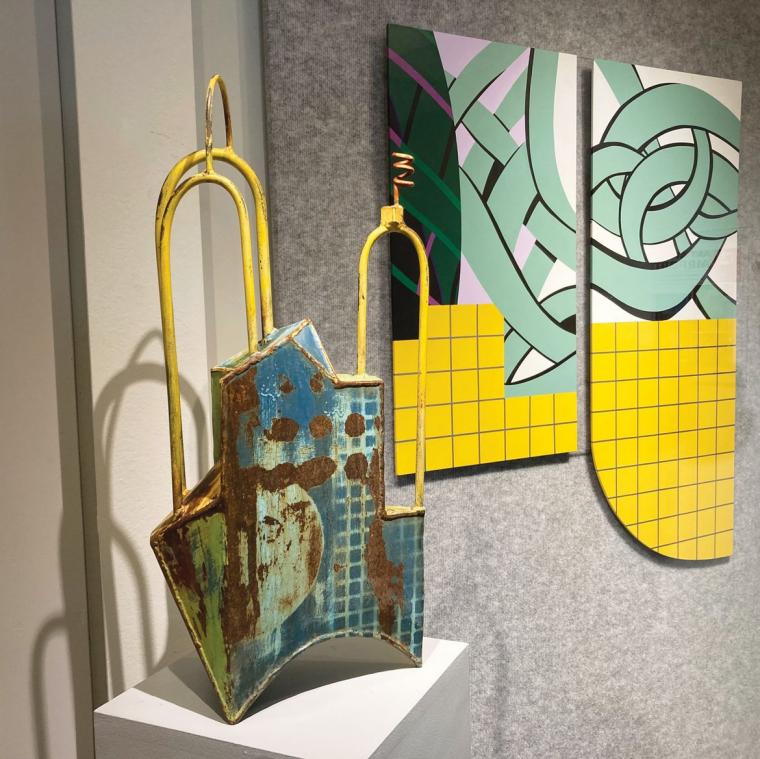
4) What about the materials and processes do you find most satisfying or enjoyable when it goes as planned?
CS: I love using the papers and paint for the immediate color, pattern and texture. Acrylic paint dries fast so if the color doesn't work, I can quickly paint over it or add a transparent paper of another color or texture and allow the previous color to show through which can create depth and show the journey of the piece.
MM: One of the reasons I don’t do ceramics now is due to how the material dictates the schedule. Working with steel, I can work for five minutes or five weeks on something, it doesn’t know the difference and I am to balance the work/family relationship much better. I can weld in my garage, or I can weld in my driveway.
JB: A certain amount of chance is involved in any artwork … the true reward is the pleasure of discovering allusive layers of vision in the same painting.
5) What are your primary inspirational or referential sources that inform and help define concepts, shapes, patterns and colors for these pieces?
CS: The preceding piece provides me with information for the next. Often just a small part of one work will be the composition for the next.
MM: My parents unexpectedly sold their house in Moline this fall and it was the house I grew up in, full of memories and experiences. As a result of the sale, I ended up with tools, equipment, furniture and of all things, a sump pump. This little, ancient (several times rebuilt by my dad), rusty sump pump single-handedly served as the inspiration for almost the entire show.
JB: It starts with fragments of shapes, patterns, shadows, and structures I run into that I bring back to the studio like a photographer without the film. Portions of prior paintings will inform new paintings. Patterns found in a book about Celtic art and symbolism have influenced recent paintings.
6) How many pieces do you have in process at the same time, or do you work on “one at a time”?
CS: I'm strictly a one-at-a-time gal.
MM: Sometimes I feel lucky to have one piece going at a time. For this show, once things “clicked,” I worked on all but two of the ten pieces at the same time. I often loaded all the “parts” in the bed of my truck and worked on them (exploring compositions, interchanging parts and making new parts) in parking lots while waiting for my kids to finish orchestra practice or swim practice. It was both funny and disturbing to realize how little people notice about their surroundings.
JB: Usually work on four at a time and have eight or nine smaller scale miniatures going at once.
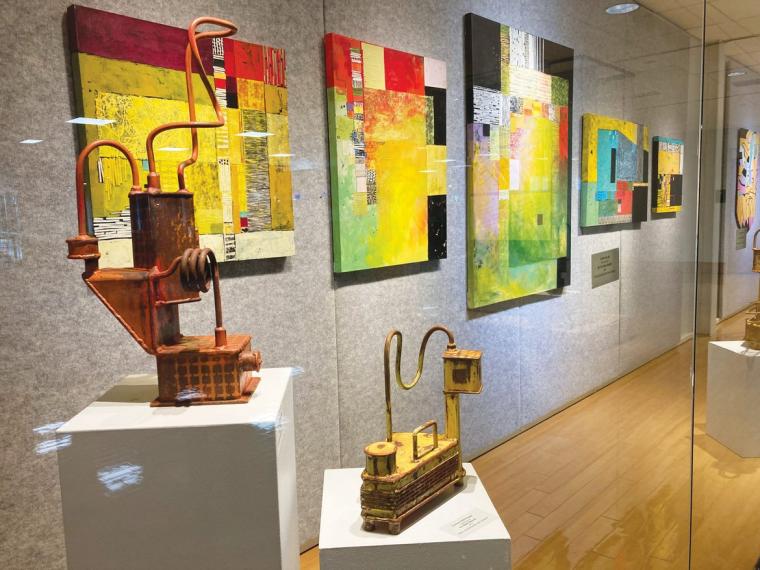
7) What new ground did you break with the pieces in this exhibit? Are there any “firsts,” processes or materials, or outcomes worth noting?
CS: Maybe not new but I'm always looking for ways to create a strong composition with ambiguous spatial relationships, flipping the positive and negative space.
MM: Utilizing the dimensional material so heavily was a first. Working in the parking lots really gave me a sense of “winning the time-management lottery” in terms of getting in 30 minutes of metal stacking and bending off the back of the truck done while then getting to go in and support my kids while they swam or played music. I just explored the materials, free from having to “get it right” because I was already considering it bonus making time outside in the beautiful fall weather.
JB: Figured out how to paint on PVC with the proper primer some time ago. With many paintings in this show, I learned how to prep 1/4”-thick PVC for strength with a corrugated product glued to the back along with what adhesives worked the best. In the past I used to have to glue blocks on the back of the painting to take the hanging screws and wire. Now with the corrugated backing, I easily run wire through the backing channels for hanging.
8) Where are your art works collected or exhibited that most people don't know about?
CS: Hospitals. University of Iowa Hospitals probably have five dozen or more works.
MM: I am thankful to have work scattered around the country. The opportunity to exhibit at the airport over the years has provided sales to people traveling through the Quad Cities and my working ending up in homes and business I don’t even know about, but enjoy thinking about.
JB: In 1975, I designed and painted a 120'-long by 18'-tall outdoor mural on the side of Color Separations' business located near the Chicago airport and adjacent to the commuter train rail. Because southbound auto drivers only had a long shot to the mural, while the train riders only saw it up close, I laid the mural out like a comic book without the storyboard borders. This was in celebration of the United States Bicentennial. When we started the mural the after the mural was completed they went from one to three shifts.
9) What visual (or otherwise) artists do you admire whose works we should all know more about?
CS: I've learned to appreciate "outsider art" more. It's direct and honest. I suppose some past influences are Matisse, Stella, Diebenkorn, and Hundertwasser.
MM: Support local college student sales where with seed money for welders, materials, or safety equipment.
JB: Painters Henri Matisse, Stuart Davis, Roy Lichtenstein, and sculptors Alexander Calder, Martin Puryear, Louise Nevelson.
For more information on the artists, visit CorrineSmith.net, MattMoyerDesign.com, and JEBowden.com. For more on their current airport exhibits, visit QuadCityArts.com.


